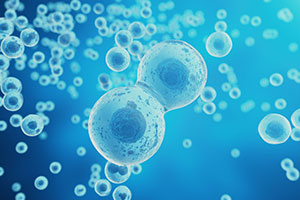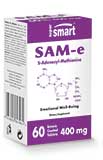24-03-2015
SAMe involved in multiple biochemical processes
 S-adenosyl-methionine or SAMe is a natural compound found in every cell in the human body. It is involved in numerous biochemical processes, its main function being that of a methyl group donor. A large number of studies suggest that SAMe nutritional supplements constitute a reliable and effective way of treating depression, osteoarthritis and liver disease.
S-adenosyl-methionine or SAMe is a natural compound found in every cell in the human body. It is involved in numerous biochemical processes, its main function being that of a methyl group donor. A large number of studies suggest that SAMe nutritional supplements constitute a reliable and effective way of treating depression, osteoarthritis and liver disease.
SAMe is made in the body from methionine and adenosine triphosphate (ATP) by methionine adenosyltransferase enzymes, in order to participate in methylation reactions. It functions as a methyl group donor in a large number of reactions which are catalysed by methyltransferase enzymes.
Once it has donated a methyl group, SAMe is converted into S-adenosyl-homocysteine which is itself rapidly converted into homocysteine. When biochemical conditions are favourable, SAMe can be regenerated. This cycle of SAMe synthesis and breakdown is essential to health.
SAMe synthesis is dependent on the metabolism of vitamin B12 and folates. A decrease in levels of these vitamins and SAMe is associated with a number of disease states.
SAMe essential for breakdown of homocysteine
Elevated homocysteine levels are linked to increased risk of cardiovascualar disease. When intermediary metabolites essential to the synthesis and regeneration of SAMe are present in sufficient quantities, there is no accumulation of homocysteine. SAMe is vital for breaking down homocysteine; indeed it has been suggested for this reason that it may play an important role in cardiovascular health.
Methyl group donor
SAMe helps convert other molecules into substances more useful to the body via a whole variety of chemical reactions. As a methyl group donor, it helps the brain produce vitally important neurotransmitters such as dopamine, serotonin or norepinephrine from substrate molecules. Methyl groups are chemical entities (one carbon atom bonded to three hydrogen atoms) which are added to or removed from other molecules in order to change their properties. A compound can be activated and function either as an agonist, promoting certain biological responses, or as an antagonist, interfering with normal or pathological responses.As effective as anti-depressant drugs
In 2002, a US government agency published a report entitled ‘S-Adenosyl-L-methionine for depression, osteoarthritis and liver disease’. It reviewed 47 studies on SAMe and depression, concluding that “Compared with conventional antidepressant medication, treatment with SAMe was not associated with a significant difference in outcomes”. In other words, SAMe was judged to be just as effective as standard antidepressant drugs at treating depression1.A number of studies comparing SAMe with a standard tricyclic anti-depressant drug have shown them to be equally effective. SAMe works faster too and has no real side-effects. In a multi-centre study conducted in Italy, for example, researchers reported the same anti-depressant benefits from daily doses of 1600mg of SAMe and 150mg of imipramine, a tricyclic drug. They also emphasised that far fewer side effects were observed in the patients taking SAMe. In contrast, the side effects of imipramine and some other tricylic anti-depressants are so numerous and serious that a significant number of doctors are reluctant to prescribe them.
However, those with bi-polar or manic depression should not take SAMe as it may trigger anxiety attacks or manic-depressive episodes.
SAMe can be used in conjunction with anti-depressant drugs and may actually boost their efficacy. Recommended doses range from 400-1600mg a day, to be taken on an empty stomach if possible. Some people suffering from severe depression may need to take higher doses2.
Important for the health of the liver
Through a reaction called trans-sulphuration, SAMe stimulates the production of glutathione, a major antioxidant that controls free radical generation in the body. It is in the liver that this vital endogenous antioxidant performs one of its key functions – that of helping to eliminate toxins 3. SAMe supplementation stimulates glutathione levels and has been used to treat various liver diseases such as cirrhosis and hepatitis4. Studies have shown that taking oral SAMe supplements increases glutathione levels in the liver and in red blood cells5. In a two-week, double-blind study involving 220 subjects with cholestasis, 1600mg of SAMe a day significantly improved hepatic symptoms compared with a placebo6.Promotes joint health
Scientists at the University of Maryland published a meta-analysis of randomised, controlled clinical trials on the efficacy of SAMe versus placebo or NSAIDs such as aspirin or ibuprofen at treating osteoarthritis. They concluded that “SAMe appears to be as effective as NSAIDs at reducing pain and improving functional limitation in osteoarthritis patients, but without the side-effects often associated with NSAIDs7.” In a long-term study conducted in Germany, researchers observed that SAMe produced an improvement in osteoarthritis symptoms after the first five weeks of treatment which continued over the two year study period. Patients were given 600mg/day of SAMe for the first two weeks, followed by a 400mg dose for the remainder of the study. According to the researchers, “SAMe displayed good clinical efficacy and was well-tolerated. It was also found to improve depressive feelings among patients, a problem often associated with osteoarthritis. 8.”Bioavailability and absence of toxicity
A study was conducted to see if SAMe had significant bioavailability and if its use in humans was capable of producing toxic methylated compounds. Homocysteine levels were also measured, since any disruption to these levels could theoretically interfere with the SAMe supplementation. Fifteen healthy volunteers were given SAMe supplements for four weeks at twice-daily doses of 200mg, then 400mg and finally 800mg. Results showed significantly higher levels of SAMe, suggesting the nutritional supplement had good bioavailability. It also indicated an absence of toxicity, particularly of both toxic methylated metabolites and elevated homocysteine levels 9.Chirality of SAMe
Two molecules are said to be chiral if they cannot be superimposed onto each other’s mirror image. Enantiomers are the two mirror images of a chiral molecule – they have identical physical and chemical properties except when reactions affect the chirality which is the case with biological mechanisms.Many chiral molecules are found in living organisms but most of the time, only one of the two enantiomer forms is present. When scientists try to reproduce these very specific natural molecules, they are never able to obtain a mix of the two forms of molecule in equal amounts. Very often only one of these molecules is found in Nature - the form most useful to the body.
SAMe, which is biologically synthesised by AdoMet synthetase, has an S configuration at the sulphur atom. Under normal physiological or storage conditions, the chiral sulphonium spontaneously racemises to form a mixture of SAMe S and R isomers. SAMe’s chirality significantly affects its activity. The R isomer is not accepted as a substrate for SAMe-dependent methyltransferases. Thus the S form is the biologically active isomer and should be present at a level of at least 75% in nutritional supplements if they are to offer optimal efficacy.
1. National patterns of medication treatment for depression, 1987 to 2001, Primary Care Companion J. Clin. Psychiatry, 2001, 3(6): 232-235.
2. S-adenosyl-L-methionine in the treatment of depression: a review of the evidence, Am. J. Clin. Nutr., 2002 Nov, 76(5): 1158S-61S.
3. S-Adenosylméthionine : from the bench to the bedside - molecular basis of a pleiotrophic molecule, Am. J. Clin. Nutr., 2002 Nov, 76(5): 1151S-7S.
4. Advances in alcoholic liver disease, Best Pract. Res. Clin. Gastroenterol., 2003 Aug, 17(4) : 625-47.
5. Effect of SAMe administration on red blood cell cysteine and glutathione levels in alcoholic patients with or without liver disease, Alcohol, 1994 Sept, 29 Nov, 76(5): 1183-7S.
6. Oral SAMe in the symptomatic treatment of intrahepatic cholestasis. A double-blind, placebo-controlled study, Gastroenterology, 1990, 99: 211-215.
7. Safety and efficacy of SAMe for osteoarthritis, J. Fam. Pract. 2002 May, 51(5): 425-30.
8. A long-term (two years) clinical trial with SAMe for the treatment of osteoarthritis, Am. J. Med., 1987 Nov 20, 83 (5A): 89-94.
9. Bioavailibility and lack of toxicity of S-adenosyl-L-methionine in humans. Pharmacothrapy 24(11): 1
Order the nutrients mentioned in this article
Further reading
02-02-2015
L-tryptophan is one of eight essential amino acids in the human diet. It is the metabolic precursor of serotonin, melatonin and niacin. It was discovered...
Read more28-08-2019
Though many people are not aware of choline, it is actually recognised as an essential nutrient by the prestigious US National Academy of Medicine 1...
Read more10-10-2016
In India, turmeric is used to treat a wide variety of ailments including gastrointestinal problems, inflammation, headaches, infections and colds. It is turmeric’s curcuminoid content,...
Read more© 1997-2024 Fondation pour le Libre Choix
All rights reserved
All rights reserved
Free
Thank you for visiting our site. Before you go
REGISTER WITHClub SuperSmart
And take advantage
of exclusive benefits:
of exclusive benefits:
- Free: our weekly science-based newsletter "Nutranews"
- Special offers for club members only



















